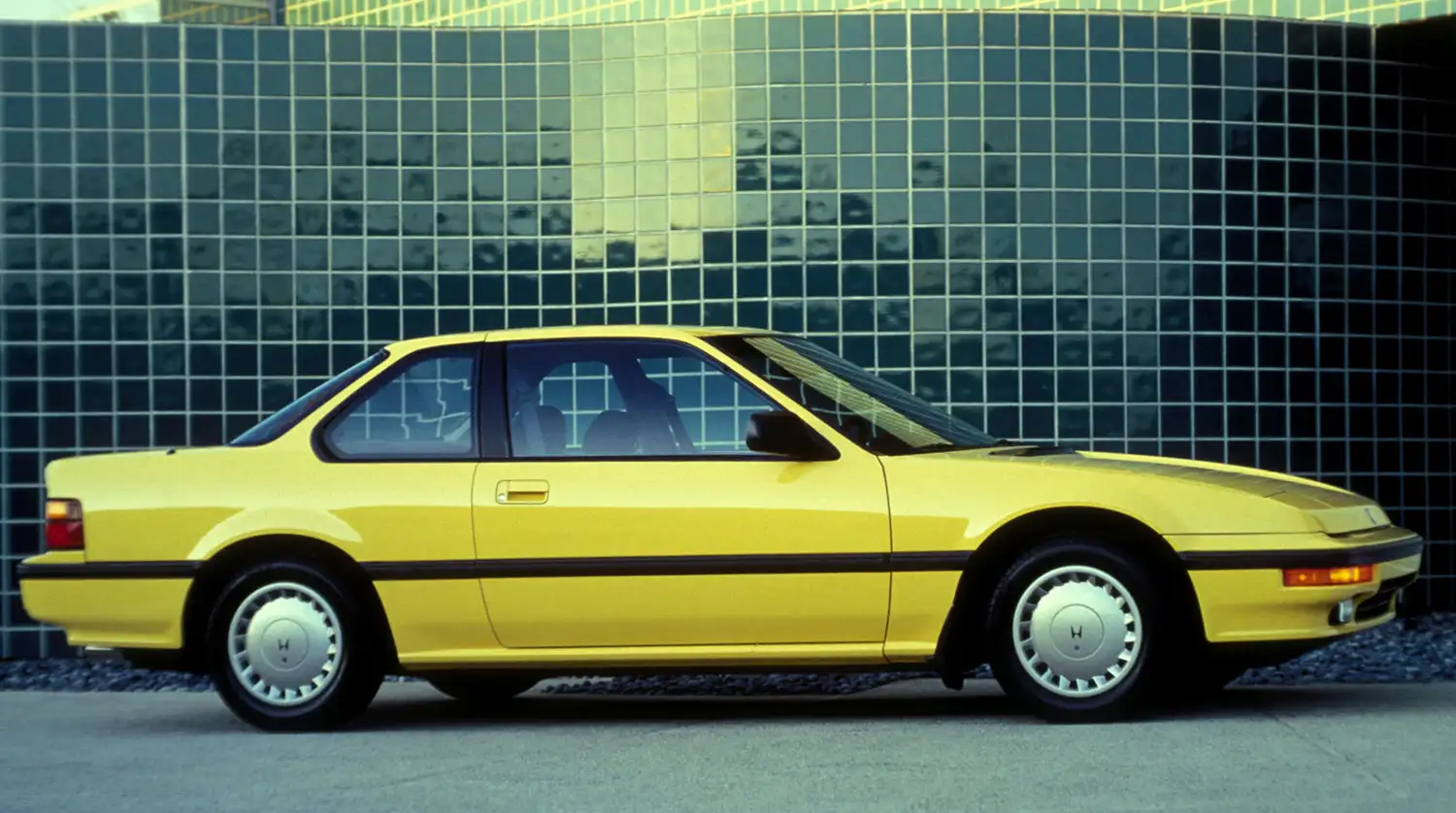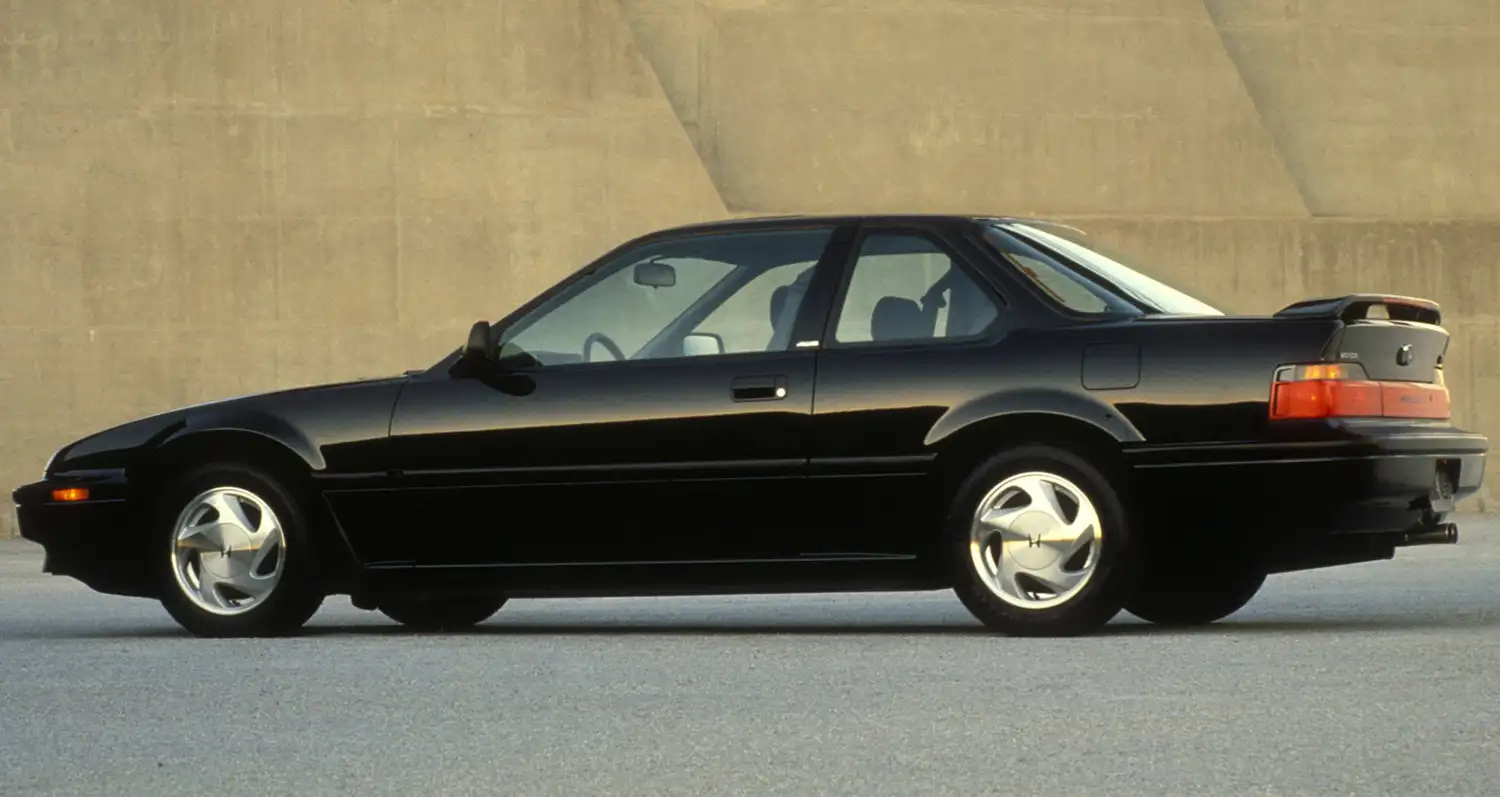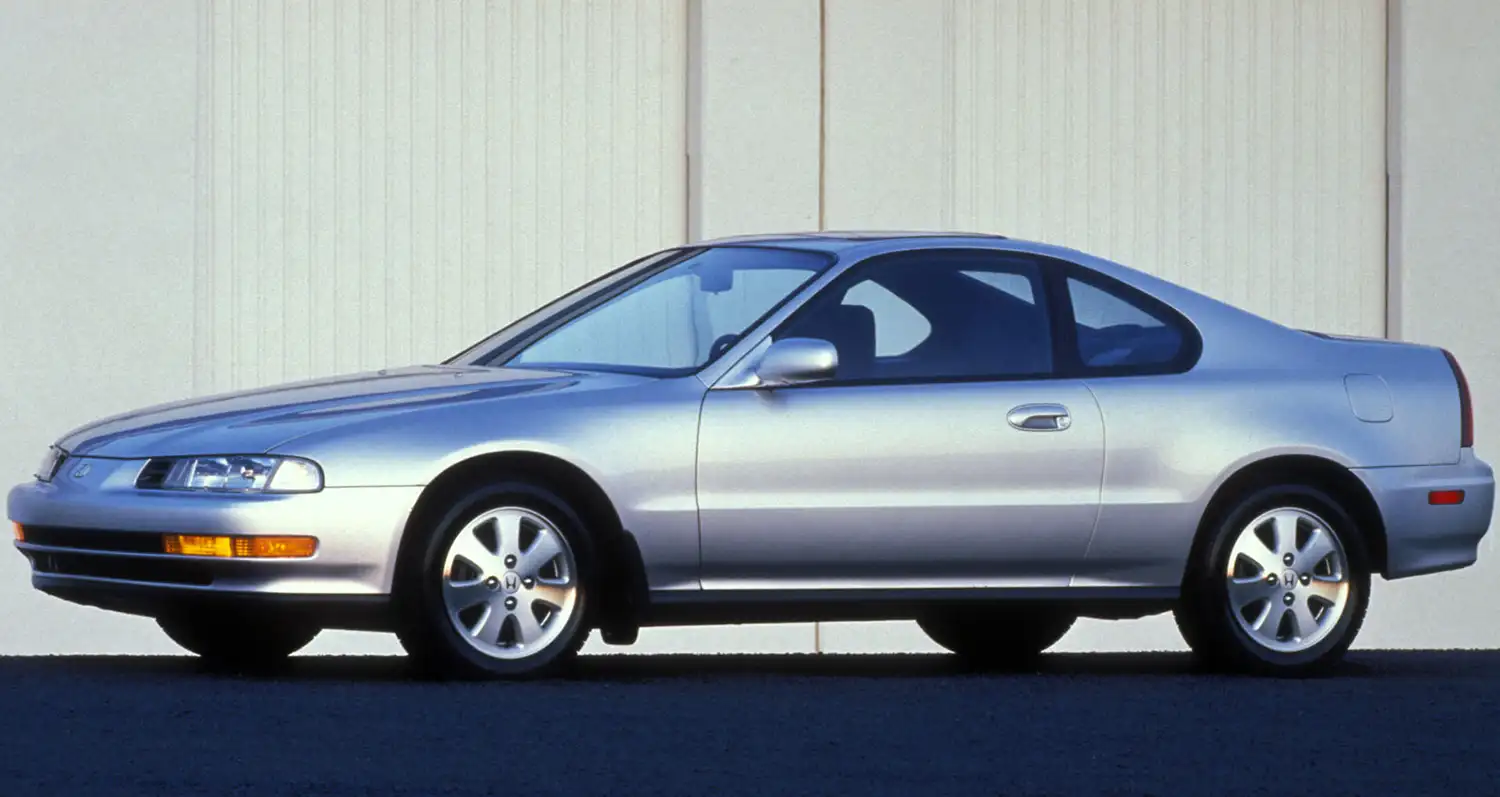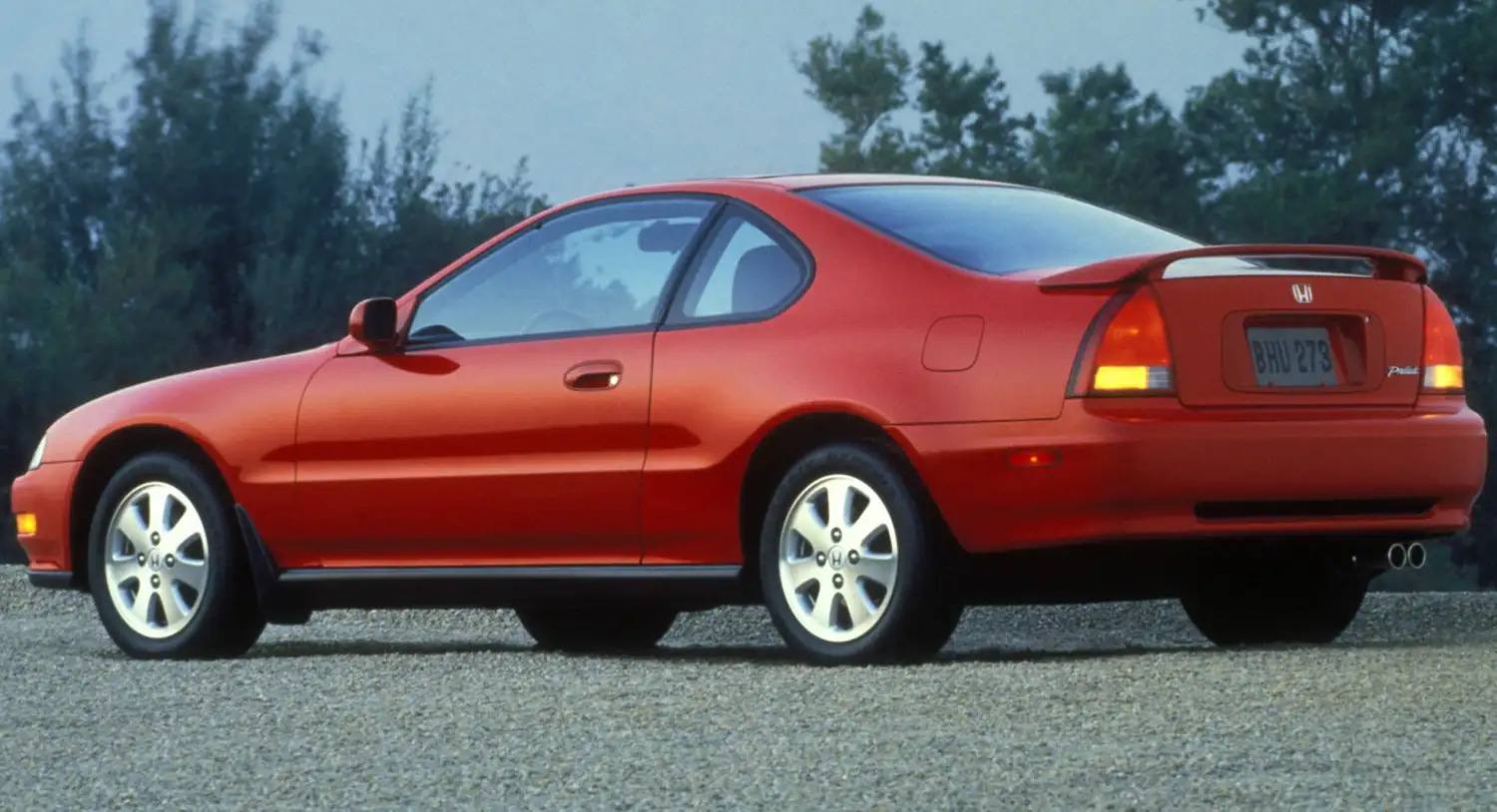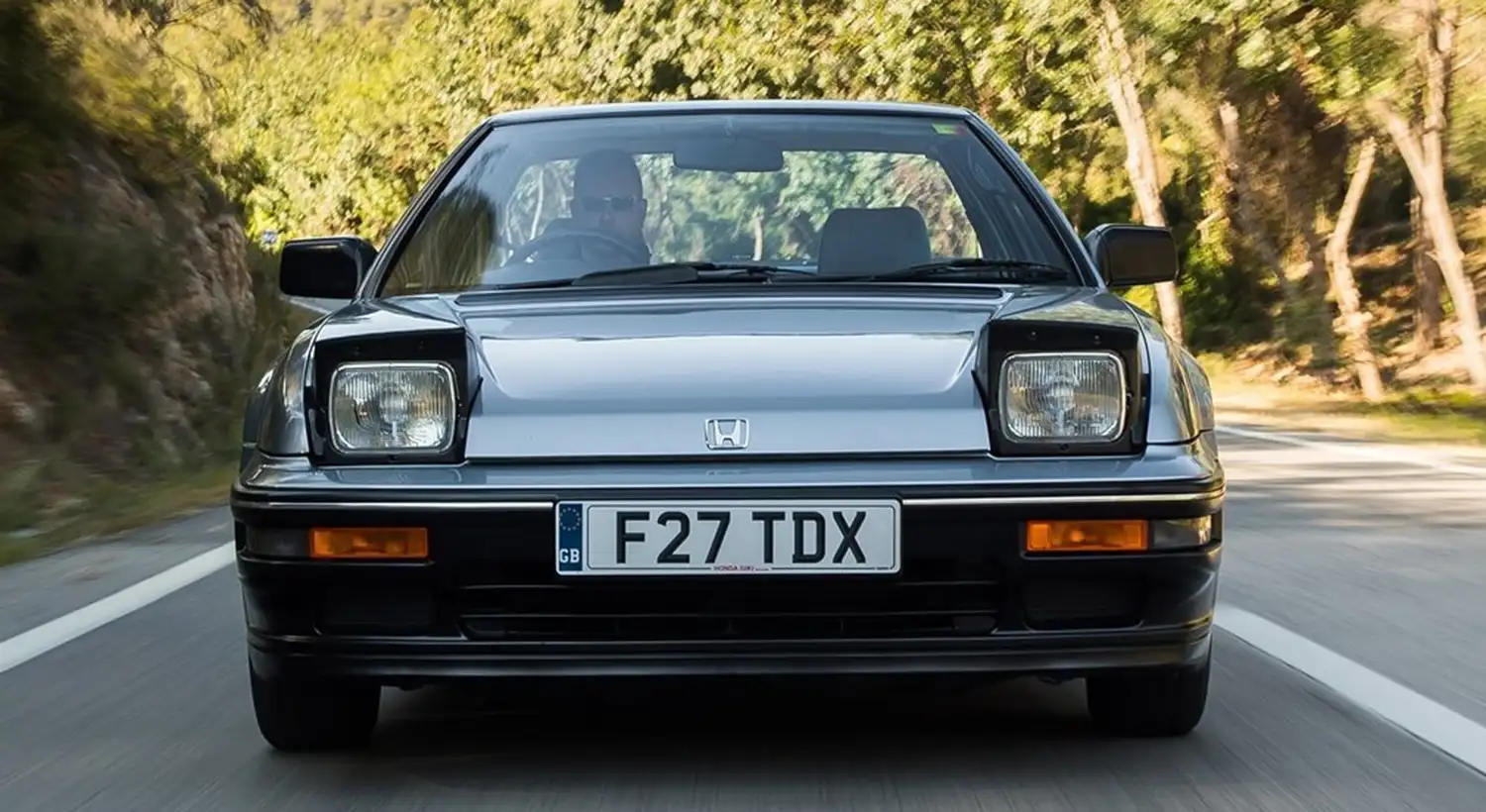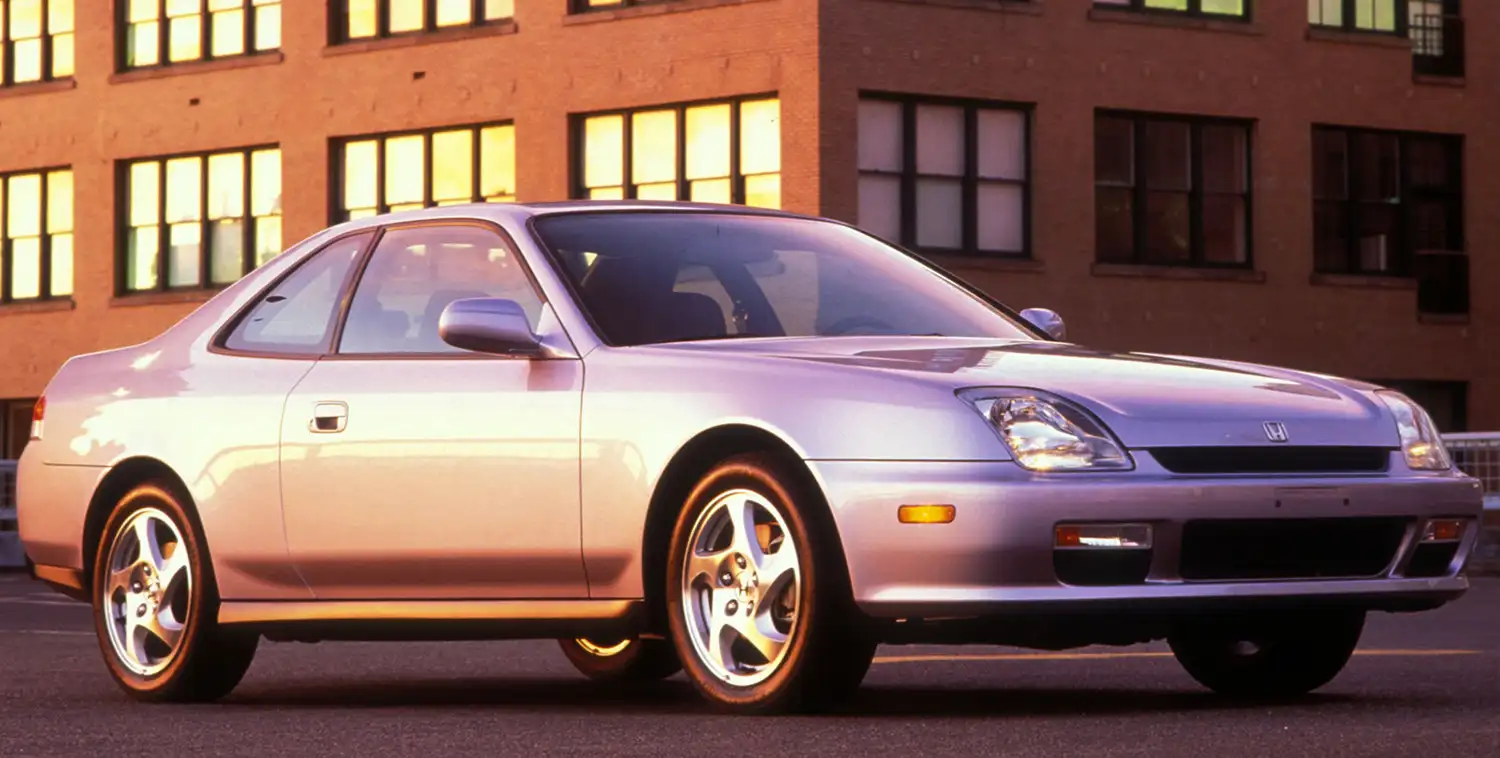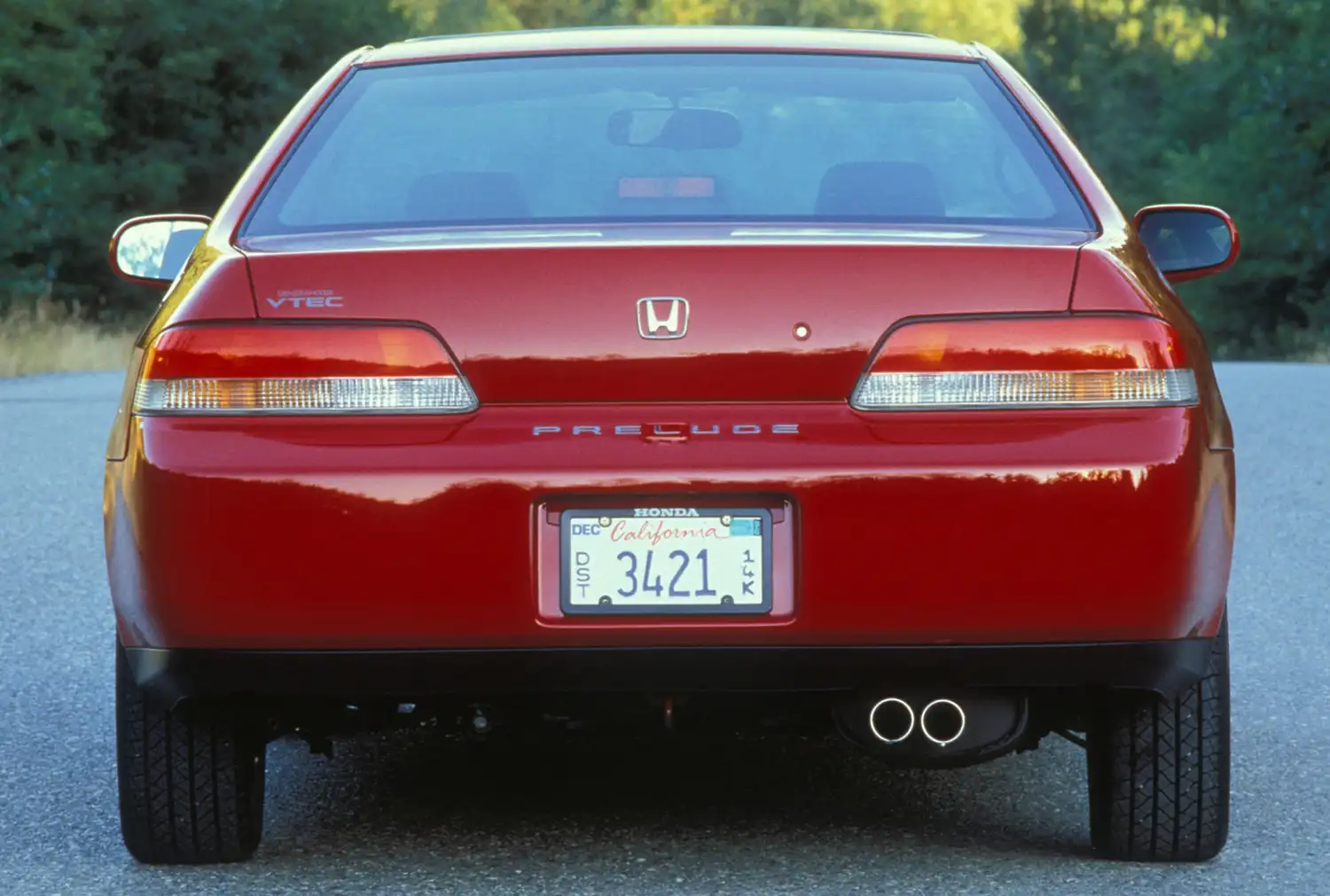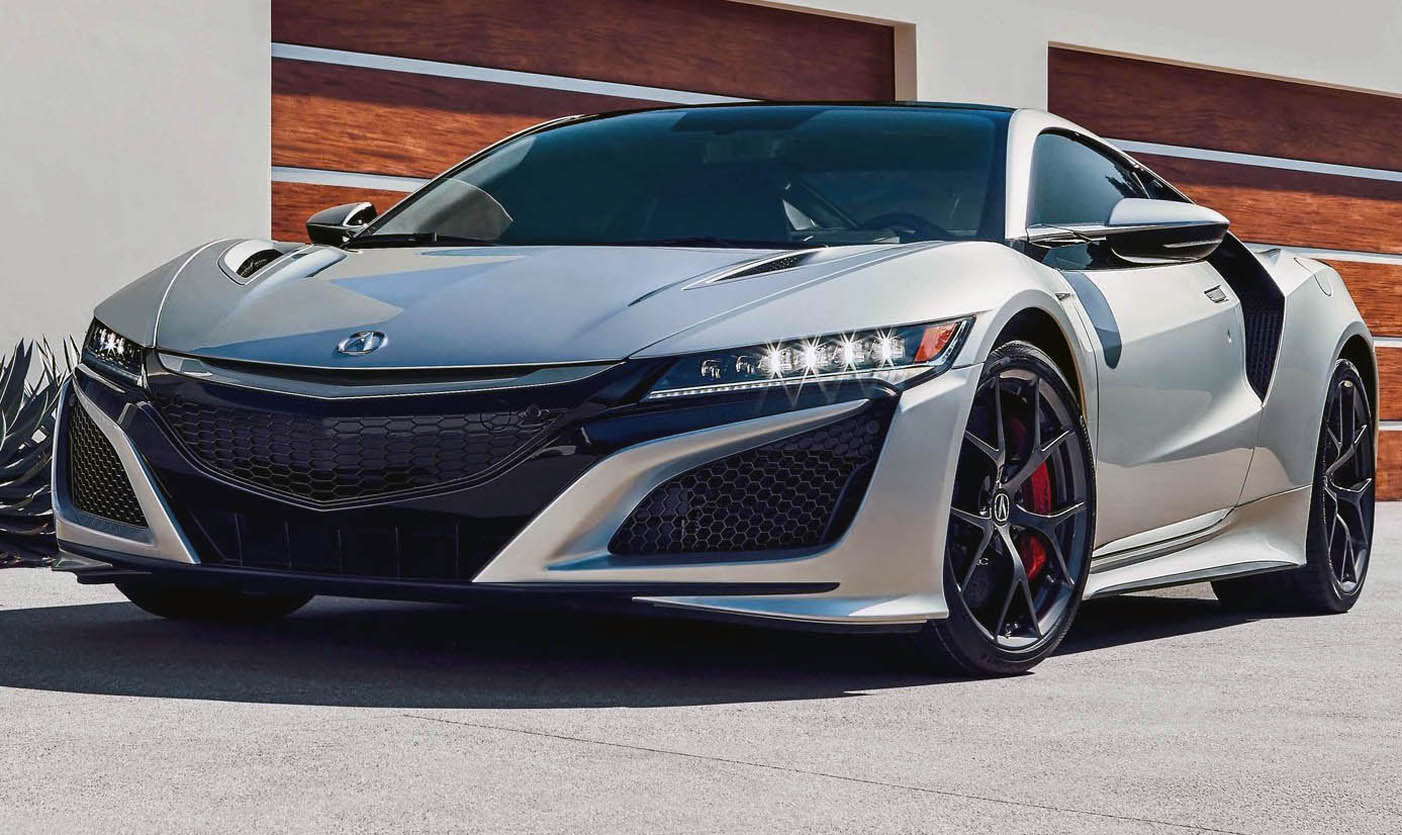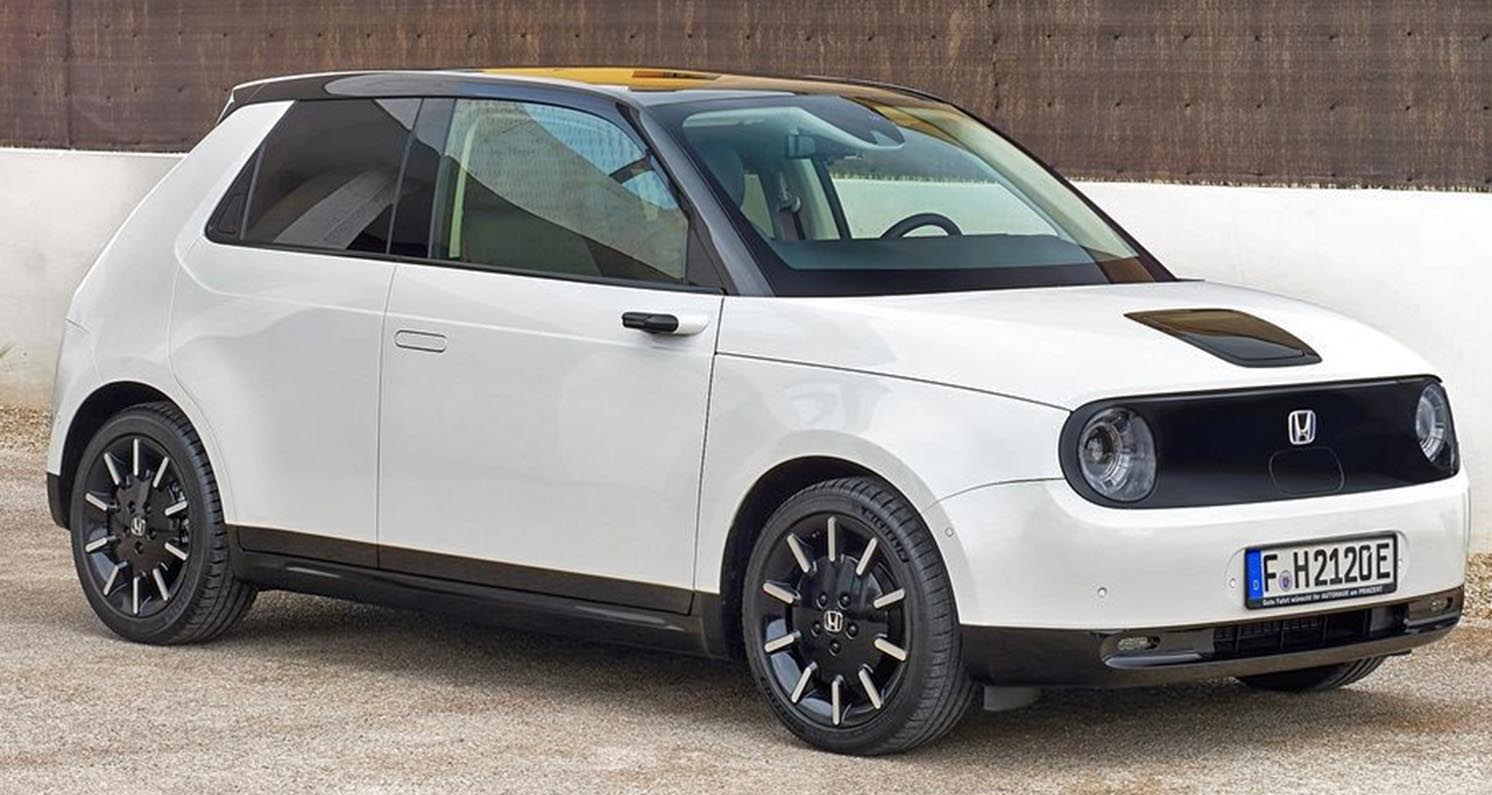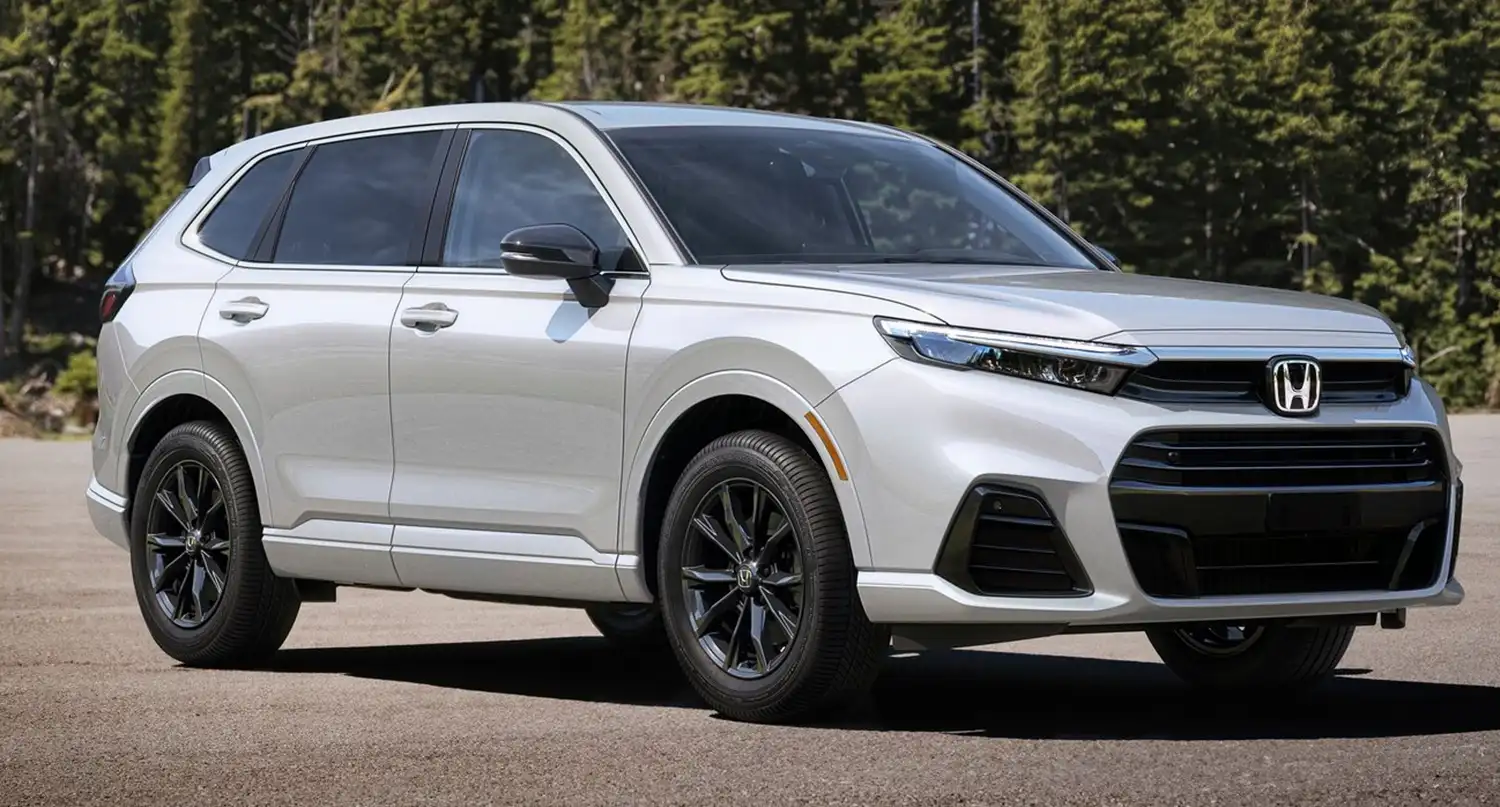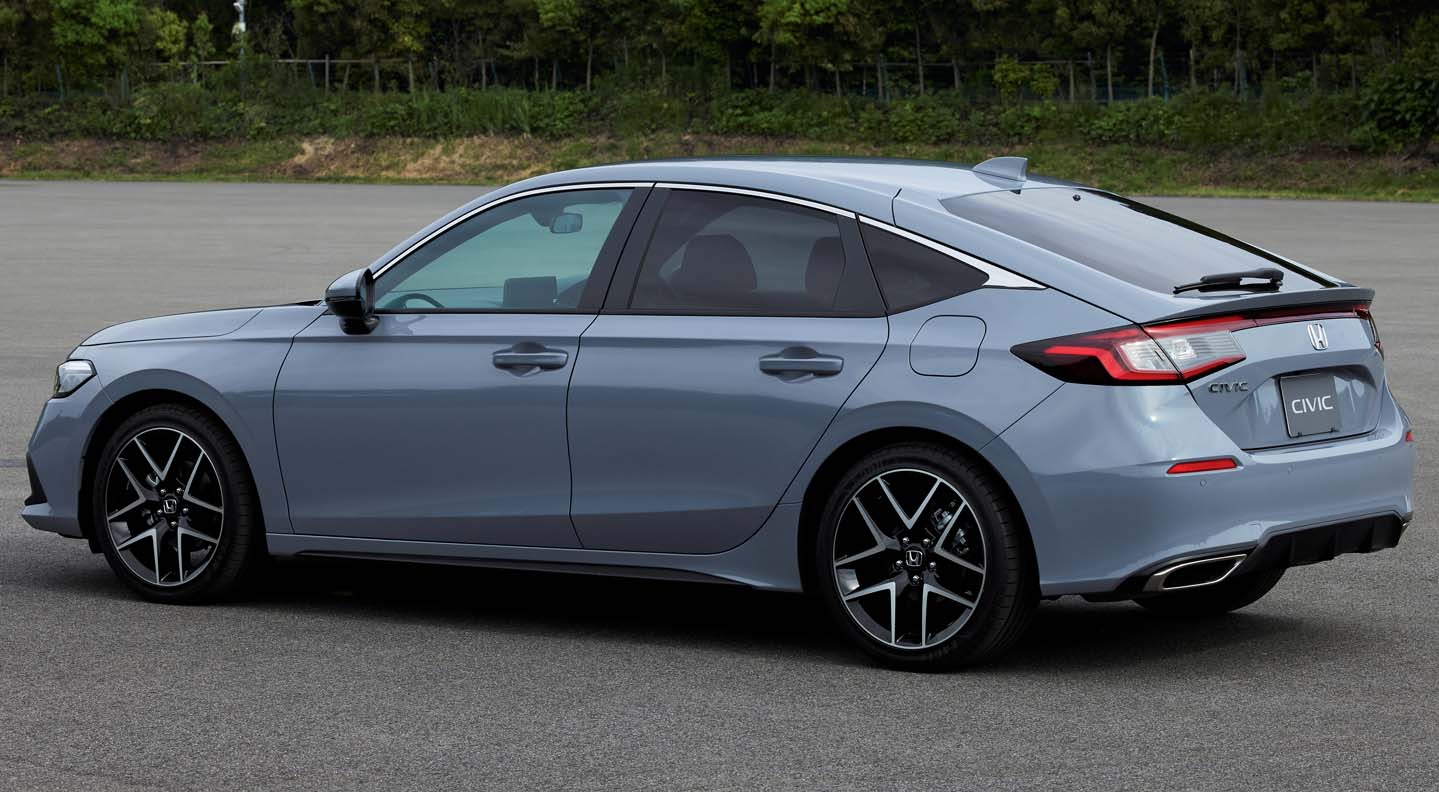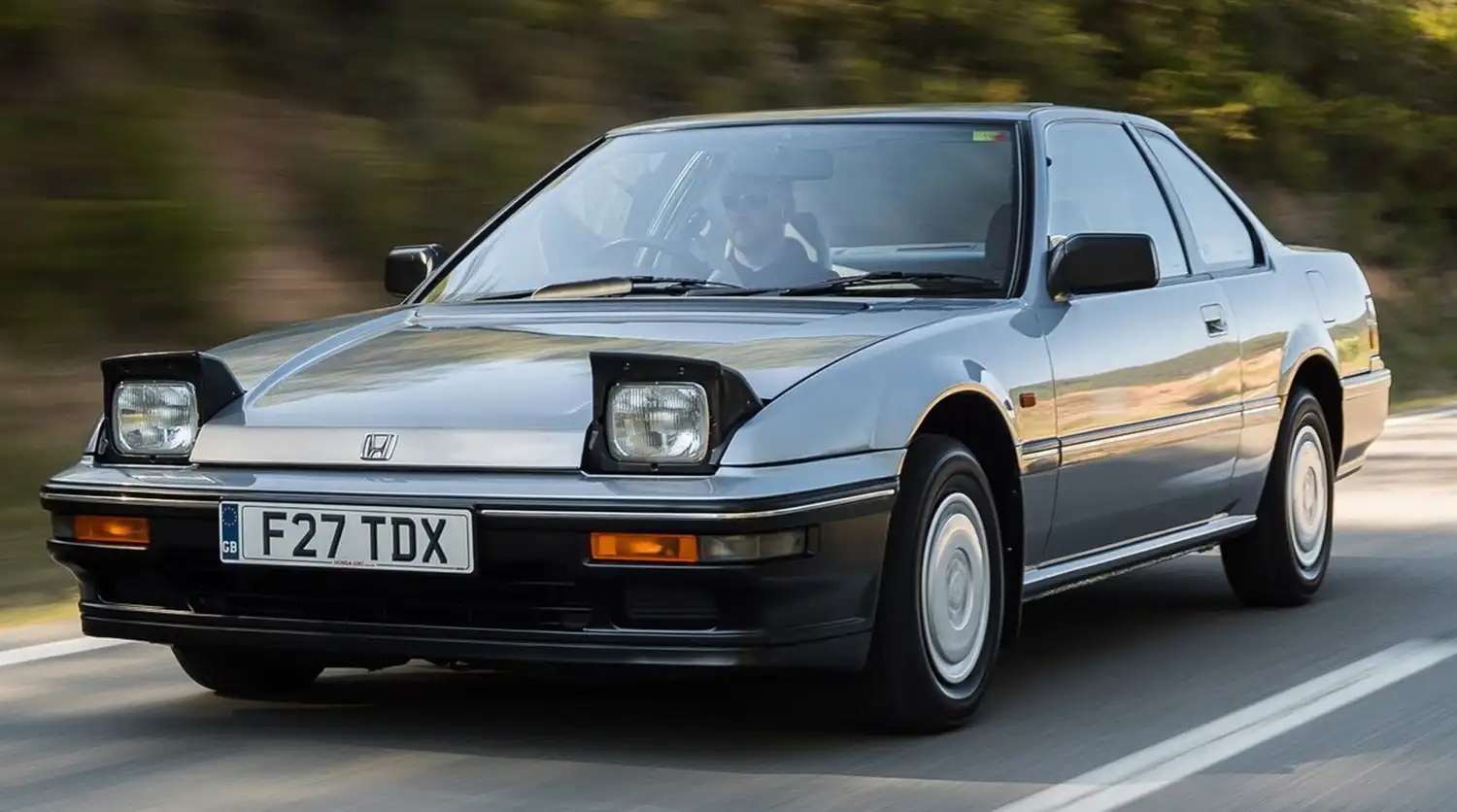
The Honda Prelude was a front wheel drive I4-engined coupe that was manufactured by Honda between 1978 and 2001. It spanned five generations of cars but was discontinued upon the release of the fourth-generation Honda Integra in Japan in late 2001, due to its decreasing sales and popularity.
The Prelude’s perennial competitor has been the Toyota Celica, another I4-powered coupe introduced several years prior to the Prelude. Throughout the 1980s, it was challenged by the Nissan Silvia, Isuzu Impulse, Mitsubishi FTO, Mitsubishi Cordia (later the Eclipse), and the Mazda MX-6.
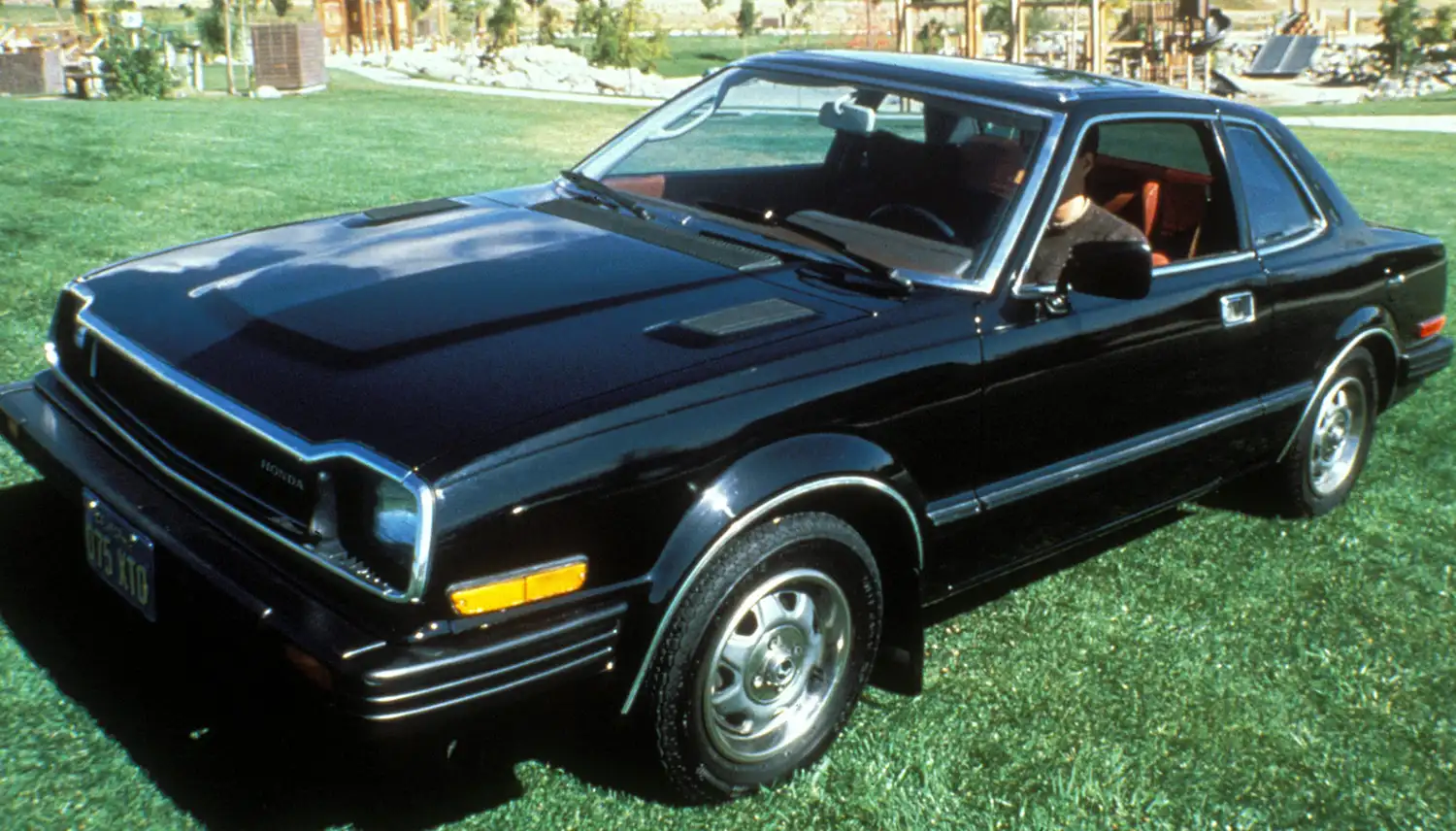
1978
The first generation Prelude was released in 1978, and was the third main model in Honda’s modern lineup, joining the Civic and the Accord. Styling of the car was a combination of both then current Civic and Accord. The Prelude was equipped with a 1751 cc SOHC CVCC I4 engine that produced 72 hp and 94 lbf-ft of torque with a 5-speed manual transmission, and 68 hp with a 2-speed automatic called the Hondamatic.
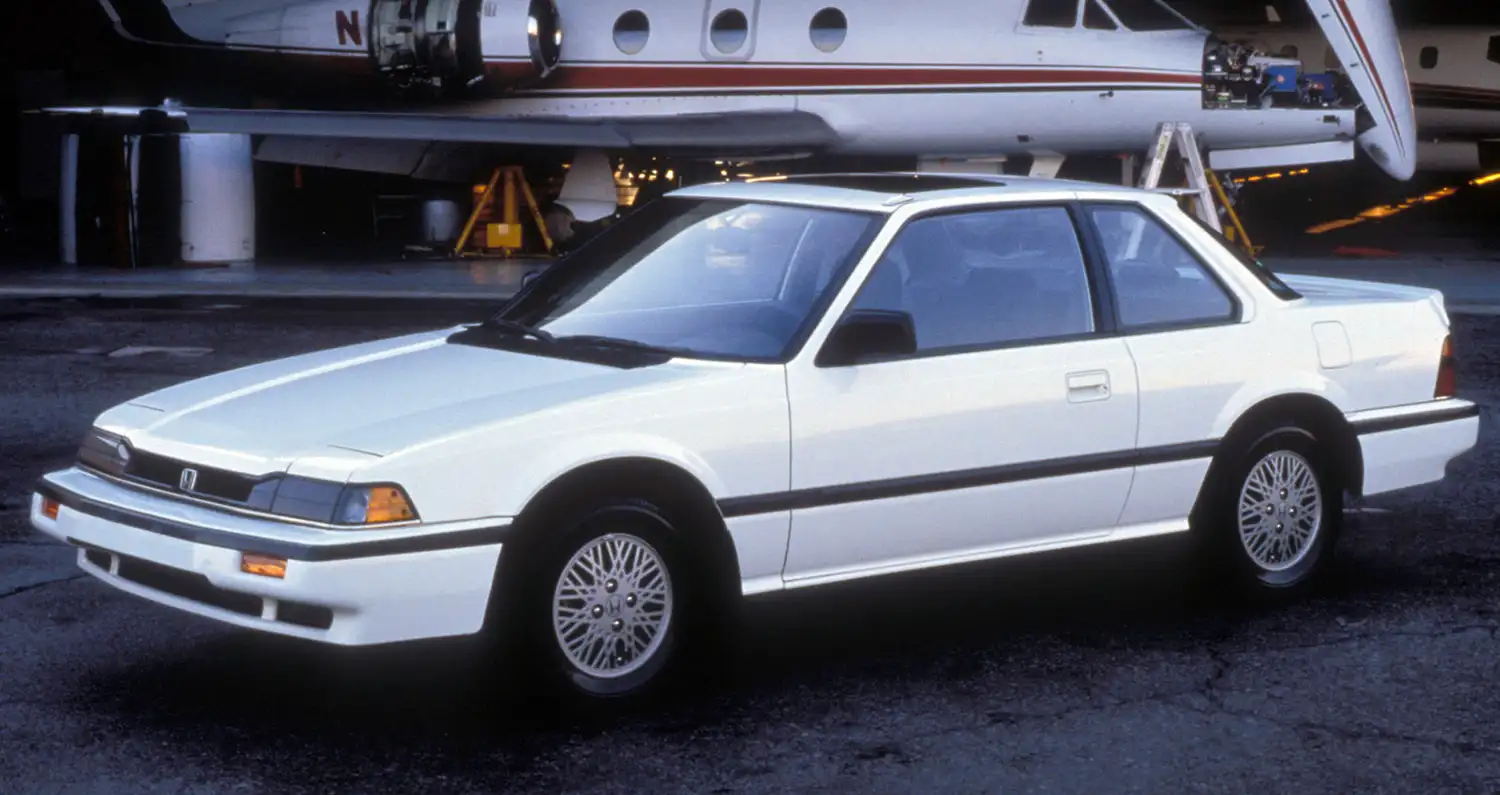
1983
The second generation Prelude was released in 1983 and was initially available with a 1.8-litre 12-valve carburated engine, producing 100 hp, and fuel injection was introduced in 1985 – in the “Si” models. In Japan, Asia and Europe, it was available with a 2-litre DOHC 16-valve PGM-FI engine, although this engine was not released until 1986 in Europe. The second generation Prelude was the first to have pop-up headlights; this allowed for a more aerodynamic front which reduced drag. Opening the headlights however, especially at higher speeds, produced more drag.
When the 2-litre 16-valve DOHC engine came out, the hood was slightly modified since the larger engine could not be fitted under the stock hood. The European version also saw slight modifications to the taillights and revised front and rear bumpers which were now color-matched. Due to the fairly low weight of the car (1,025 kg) and high power (the 16-valve engine produced 137 hp) the car was surprisingly nimble, something most Preludes were not in comparison to their competitors, until the VTEC engines came out.
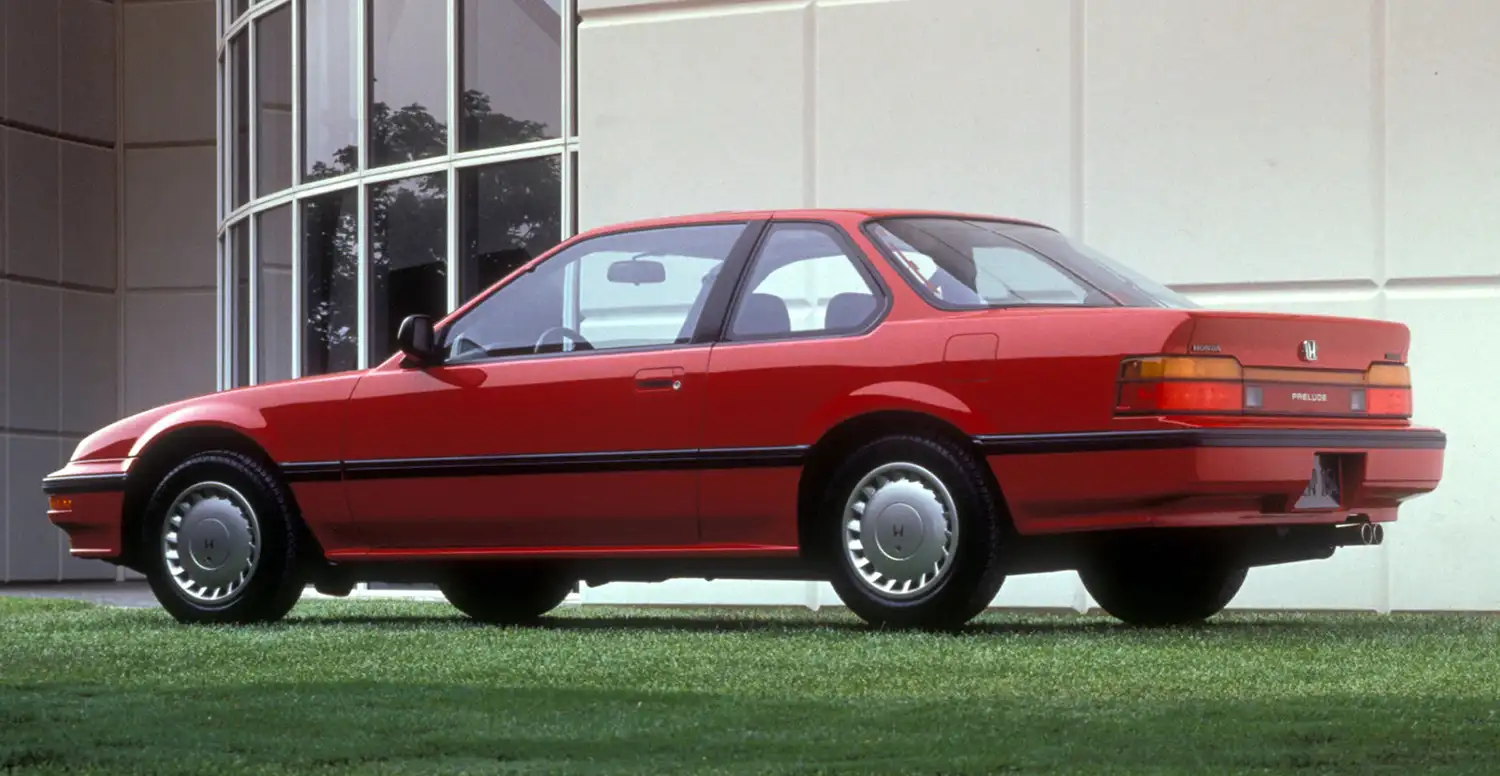
1987
On 9 April 1987, the third-generation Prelude was released in the Japanese domestic market and released later that year worldwide, being a 1988 model in North America. Featuring evolutionary styling from its predecessor, it shared design cues from the Honda NSX that would be introduced later in 1990. The Honda Prelude featured innovative features for its time such as a 0.34 drag coefficient, roof pillars made of high-strength metal and its signature feature, the available option of the world’s first mechanical four wheel steering system available in a mass-production passenger car. Honda had expected 30% of buyers to plump for four-wheel-steering, but the car was a runaway success in the home market and 80% of buyers did in the first year.
The third-generation Honda Prelude was exclusively powered by variants of the Honda B20A engine, a base carbureted version with a SOHC 12-valve valvetrain, or a DOHC variant with Honda’s PGM-FI fuel injection and 16 valves. The engine was tilted backwards by 18 degrees, which made it possible to make the hood 30 mm (1.2 in) lower than on the previous generation.
It was well received by judges of the European Car of the Year accolade for 1988, finished third in a contest where the Peugeot 405 was the runaway winner and the Citroën AX came second. This was one of the best performances by a Japanese built or branded car until the Nissan Micra won the award five years later.
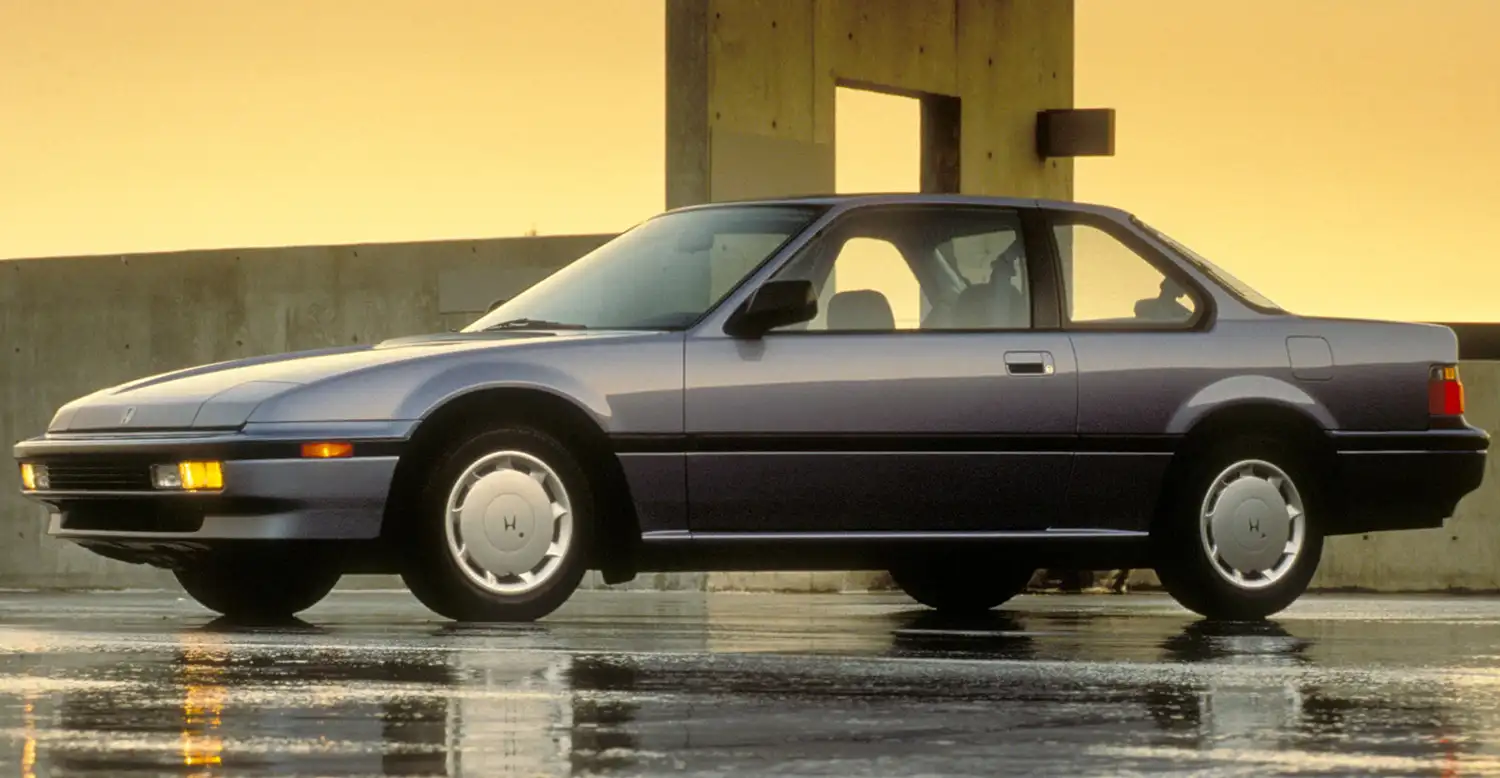
1990
In 1990 the Honda Prelude was given a facelift from the previous third generation (1987-1989) styling to a newer look. This facelift featured slightly larger tail lights with clear indicators instead of the previous orange indicators. The front bumper on the 1990 Preludes was also changed to feature clear indicators and park lamps and different styling.
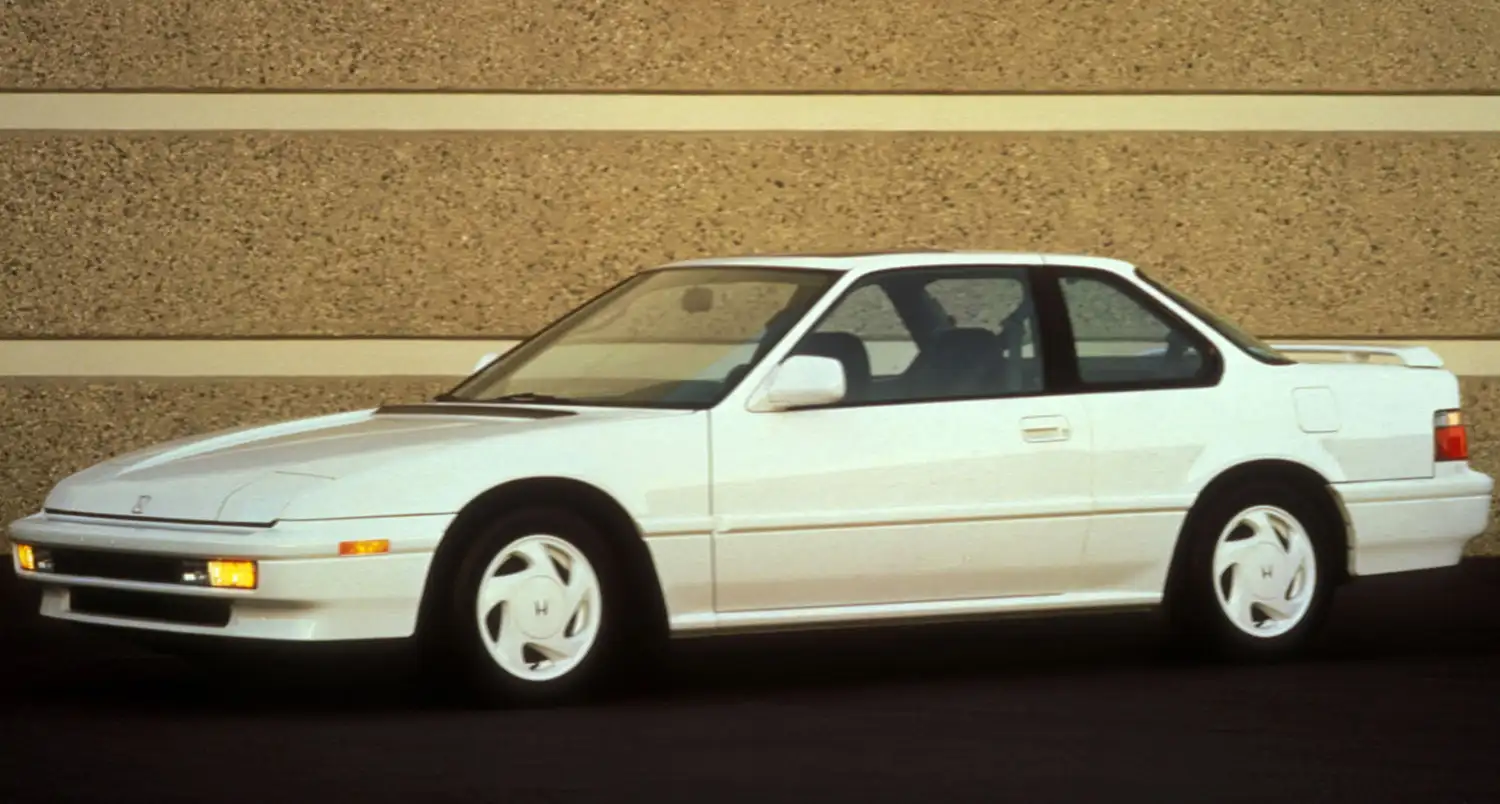
Honda in 1990, released the Prelude SiStates. This car was on a limited production line and very few were built, it featured 4WS (Four Wheel Steering), ALB (ABS), Limited Slip Differential, Leather wrapped steering wheel and gear shift leaver, Extra sound deadening on firewall and hood, rear wiper and washer, and many more features that were usually options. It also featured a unique B21A engine that was only produced for the SiStates. This model was only available in Japan.
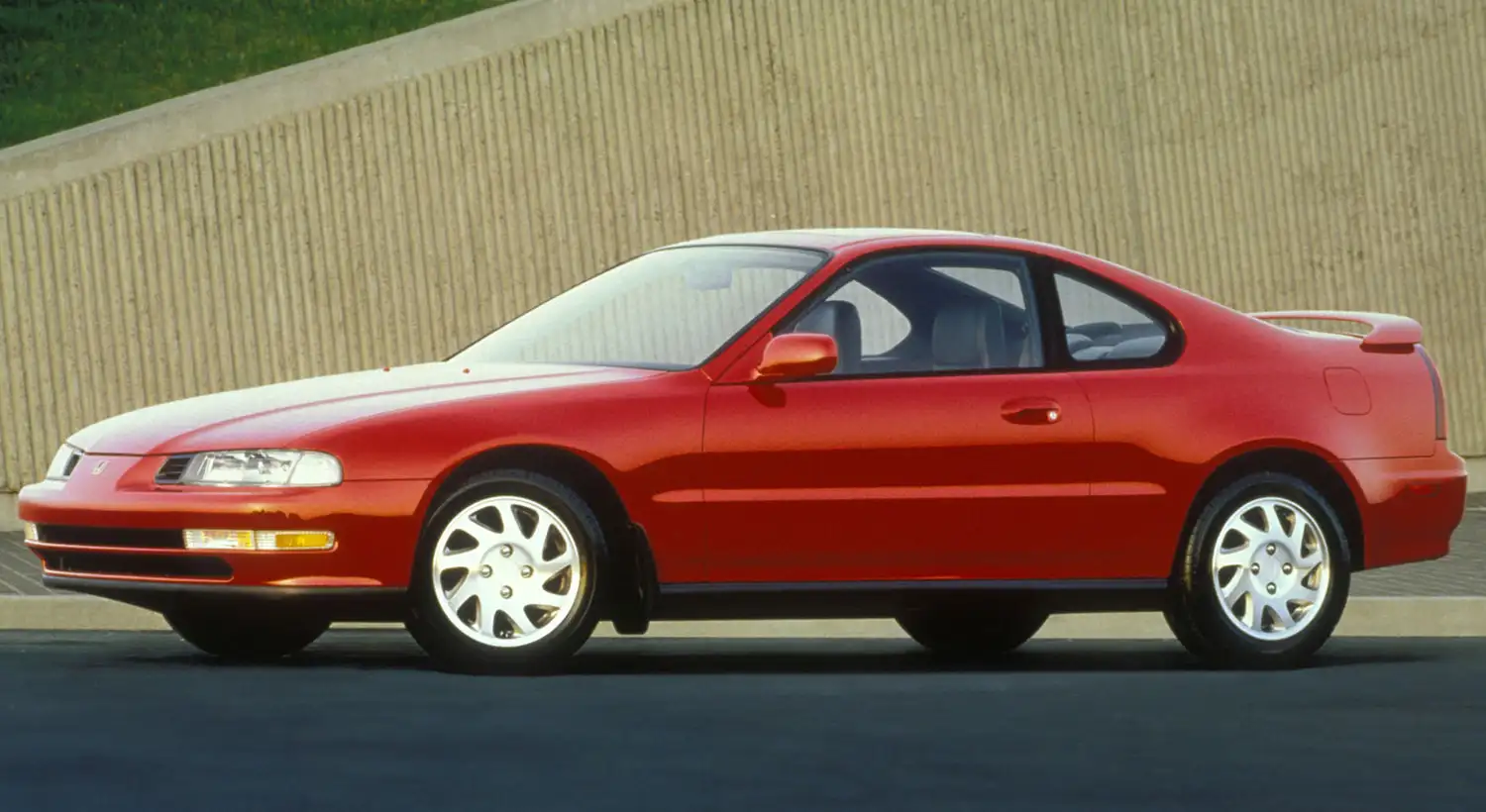
1991
In 1991, there was a major overhaul of the fourth generation Prelude, released outside of Japan in 1992. The car had a 58% front and 42% rear weight distribution. The four wheel steering system was changed to an electronic version and the engine was increased in size from 2.1 L to 2.2 L for the base “S” model (SOHC F22A1 engine, 135 hp (101 kW) @ 5200 rpm, 142 ft·lbf (193 N·m) @ 4000 rpm) and “VTEC” model (DOHC VTEC H22A1, 190 hp (143 kW) @ 6800 rpm, 158 ft·lbf (212 N·m) @ 5500 rpm), with a less performance-oriented 2.3 L for the “Si” (DOHC H23A1, 160 hp (115 kW) @ 5800 rpm, 156 ft·lbf (212 N·m) @ 5300 rpm.
In the UK, there was also a 2.0i model that was rated around 125 bhp (93 kW). 1993 was the last year that the “Si-VTEC” name was used, and starting in 1994 it shortened to just “VTEC” and stayed that way throughout the rest of the generation. The Prelude 2.2 VTEC is sometimes incorrectly referred to as a VTi. In Canada, the Si was called the SR, and the VTEC was called the SR-V.
This model also marked the end for the pop-up headlights and a lot of other design features that had become “prelude standard”. The rear end was no longer flat and wide; but wide, rounded and fairly high in comparison. The front fascia of the car became wider with fixed headlights. The glass sunroof made way for a steel sliding roof which no longer retracted into the car but extended out and over it. This in effect creates a spoiler which reduced air noise when driving.
The dashboard was generally accepted as the extraordinary feature of this model. The dashboard stretched from left to right in the car, being equal in over the full length and housing all dials and indicators. The light blue backlighting introduced in the third generation was continued. Later models (1994 and on) also featured translucent speedometer and tachometer needles. In Japan, there was also an in-dash television set available as a standard option; as a result, many enthusiasts have tried to modify their Preludes’ dashboards in order to fit a small television set. The Japanese version of the Prelude also had certain options which were never found in state-bound models but did show up in the Canadian market. For instance, the Japanese Prelude had power folding and heated side mirrors, as well as a rear windscreen wiper while the Canadian market had heated seats. The fourth generation Prelude also shares suspension components with the fifth (94-97) and sixth (98-02) generation Honda Accord.
In the UK, the Honda Prelude was never considered an essential purchase by the majority of sports car enthusiasts who overlooked it for the more trendy Toyota MR-2 and other well-known rivals. This might be partly due to the Prelude’s reportedly cramped interior, though perhaps the Prelude was also overshadowed by more prominent performance Hondas such as the Civic Type-R, the NSX and later the S2000. However, the Prelude is extremely competitive in terms of style, speed and build quality, and it has achieved something of a cult status in the UK and US where demand is still high for the sportier, manual transmission versions.
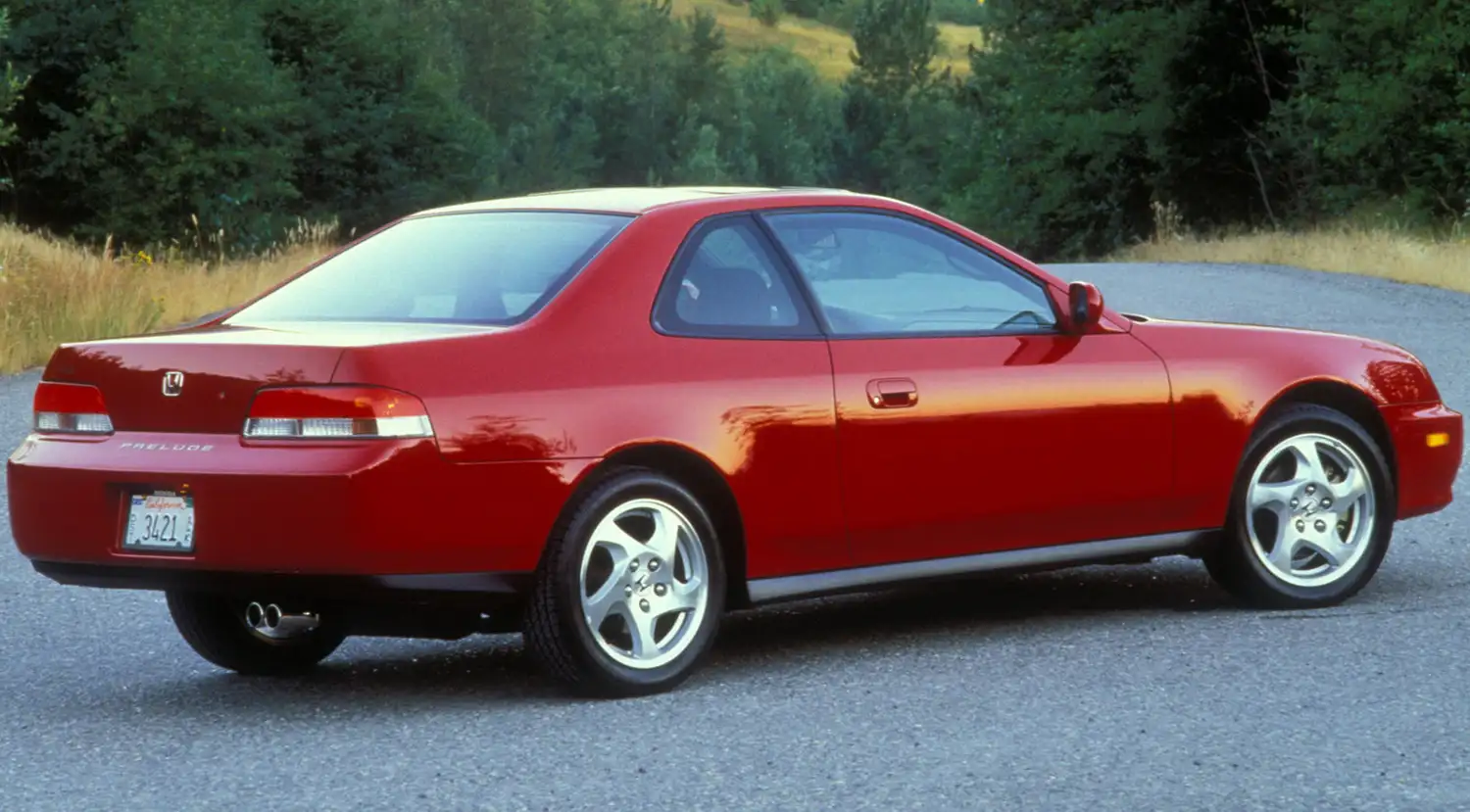
1997
The fifth generation of the Honda Prelude saw enhancements over the fourth generation, including new body styling and handling characteristics. In 2001 the Prelude was discontinued.
The fifth-generation retained an FF layout with an independent front suspension. The vehicle utilized a 63/37 weight distribution. All fifth-generation Honda Preludes came with 16 inch aluminum alloy wheels with all-season 205/50 R16 87V tires, except the Xi (14 inch steel wheels with full covers and 195/65 R14 89H tires) and Si (15 inch aluminum alloy wheels with all-season 195/60 R15 88H tires.) on which aluminum alloy rims came as a dealer option. Unlike the USDM Preludes, JDM Preludes came with rear windshield wipers (except the Xi).
The fifth-generation Prelude marked a return to the body style of the late 1980s, or third generation, in an attempt to curb slumping sales of the fourth-generation body style. The fifth-generation was assembled and distributed to many parts of the world, including Japan, the UK, the US, and Germany, among others. All models and trims stayed within the BB-chassis code (BB5-BB9) and housed either the H-series engine or F-series motor. Models available to the Japanese market included: SiR (10.6), Xi (8.8), Si (9.2), SiR S-spec (11.0) and the Type S (11.0). The US received a Base model and Type SH. Canada received the Base model, SE, and Type SH. Europe received the 2.0i (9.5) and 2.2 VTi VTEC (10.0). Australia received the Si (10.0) and the VTi-R (10.0). All fifth gen. Preludes came with an H22A ( ) except: Xi (F22B), Si (F22B), 2.0i (F20A), Si (F22Z). BB5 was the Xi, and Si-2WS trim. BB6 was the SiR-2WS trim, SiR S-spec, Type S, Base model, Type SH, SE, 2.2 VTi VTEC-2WS trim. BB7 was the Si-4WS trim. BB8 was the SiR-4WS trim, and 2.2 VTi VTEC-4WS trim. All Preludes had a fuel tank capacity of 60 L (15.9 US gal).
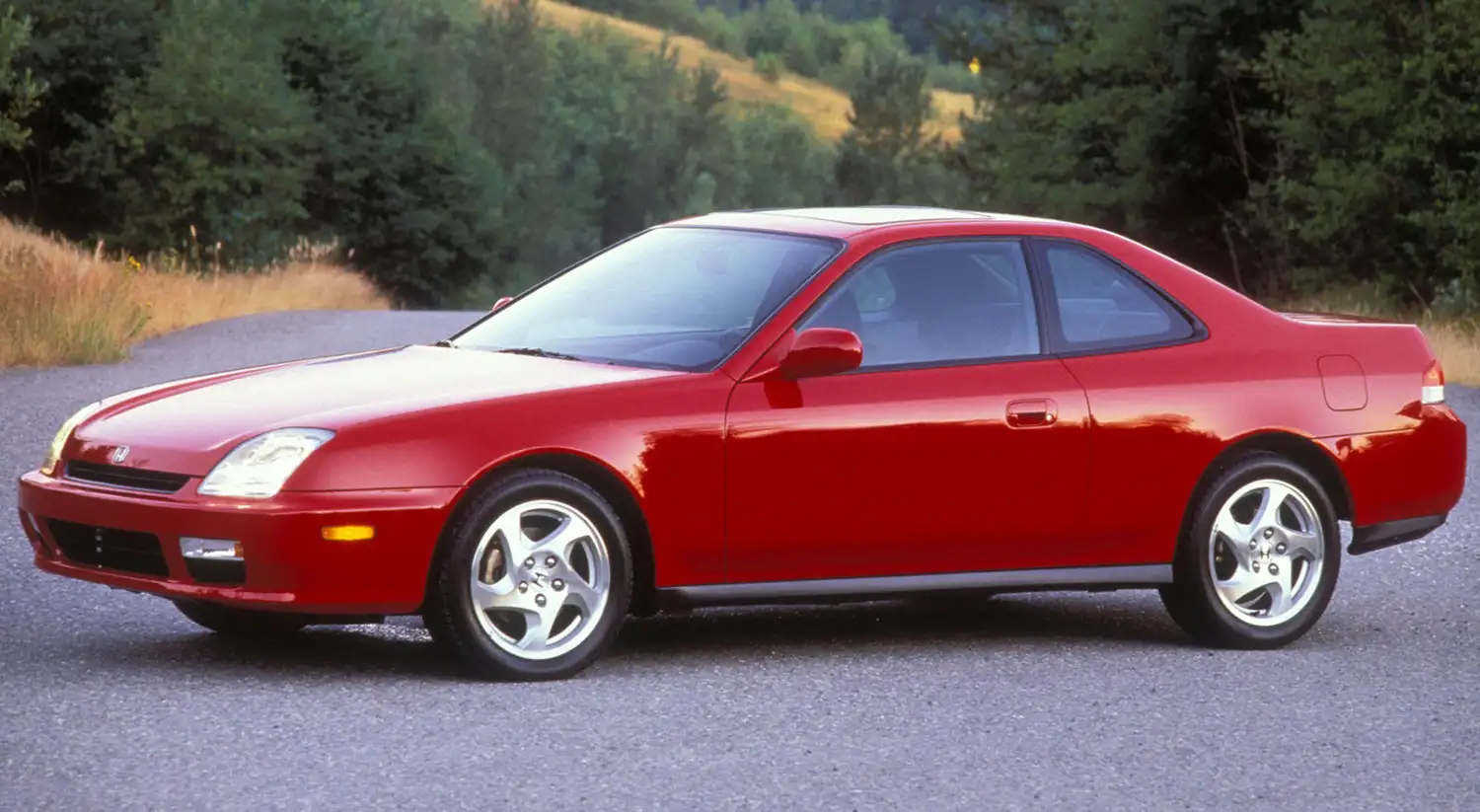
One version of the fifth-generation Prelude, the Type S, was only available in Japan. It was equipped with the 2.2 L H22A, featuring VTEC and producing 220 PS (162 kW, 217 hp) @ 7200 rpm and 22.5 kgf·m (221 N·m, 163 lb·ft) @ 6500 rpm. With a compression ratio of 11.0:1, 87.0 mm bore x 90.7 mm stroke and the VTEC-valve timing, lift and duration were adjusted to 12.2 mm|11.2 mm (intake|exhaust). Honda also overhauled the air box and replaced it with a more efficient design that is often referred to as Dynamic Chambering, along with an increased throttle body design bored to 62 mm (as opposed to the previous 60 mm). The exhaust system also was treated to a redesign as well, where the pipe design became a more cylindrical shape rather an oval shape. The 3-way catalytic converter was also increased in size, as well as the exhaust piping from 50.8 mm (2.00 in) to 57 mm (2.25 in) (tToV). With the increased power output, the suspension was equally enhanced with 15 inch front ventilated discs and 14 inch rear discs. The fifth gen. curb weight was 1,310 kg (2,882 lb) and had a ground clearance of 0.14 m (5.5 in.). Unlike the SiR S-spec that had an LSD, the Type S acquired the technology from Honda that is known as the Active Torque Transfer System (ATTS) (other terms that may be seen elsewhere that may come up are: DYCS [direct yaw control system], active yaw control system, Active Electronic Limited Slip Differential [misnomer.]) The gearing on the Type S matches all other fifth-generation Preludes that had a manual transmission except for the 5-speed 2.2 VTi VTEC and had a FD: 4.266. The Type S had an Active Control ABS system, different from the others which had the standard ABS systems. The interior featured leather laced with red stitching. Manufacturer styling options including seat lettering. The exterior styling of fifth generation Preludes was standardized for most models. All had a sunroof except for the Type S model.
There was only one other car that housed the H-series, and it would be the last of its kind until the presentation of the K-series. The Accord Type R/Rx/Torneo (or the JDM version of the name more commonly known as the Honda Accord Euro R / Torneo Euro R) housed the last line of a more refined H-series motor, which lasted from around 1998 to 2002, until the exterior was revamped and the K-series was introduced.
The USDM fifth-generation Preludes also saw enhancements in the engine, with the full line now offering VTEC H22A4 engines, an evolution of the H22A1 with higher flowing heads, making 195 hp (198 PS, 143 kW) @ 7000 rpm and 156 lb·ft (21.8 kg·m, 212 N·m) @ 5250 rpm from 1997 to 1999, and the same torque readings with 200 hp (203 PS, 147 kW) @ 7000 rpm from 1999 to 2001 with a compression ratio of 10.0:1. The USDM fifth-generation had a Type SH (“Super-Handling”) trim which featured the Active Torque Transfer System (ATTS), and, along with the 5-speed base model, shared the exact same gearing from the Type S and SiR-S spec trims in Japan (in which the Type SH transmission is the exact same as the Type S.) This system allowed Honda to overcome the limitations of front wheel drive somewhat, and in 1997, Car and Driver named the Prelude Type SH the “best-handling car under $30,000.”
Article Source: Wikipedia under the GNU Free Documentation License

